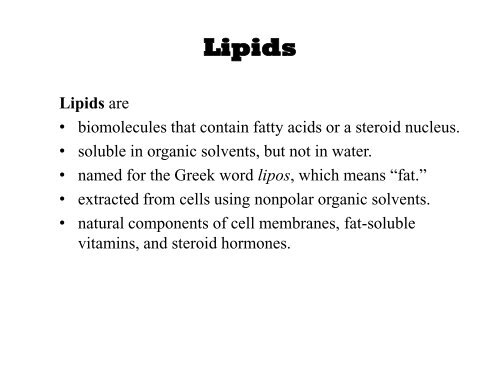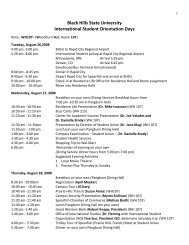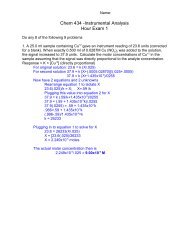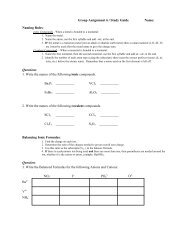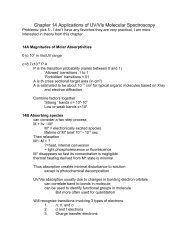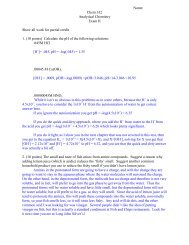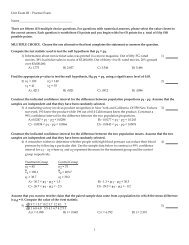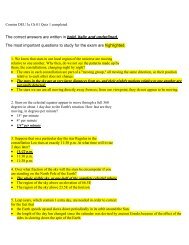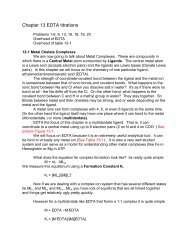Lipids
Lipids
Lipids
You also want an ePaper? Increase the reach of your titles
YUMPU automatically turns print PDFs into web optimized ePapers that Google loves.
<strong>Lipids</strong><strong>Lipids</strong> are• biomolecules that contain fatty acids or a steroid nucleus.• soluble in organic solvents, but not in water.• named for the Greek word lipos, which means ―fat.‖• extracted from cells using nonpolar organic solvents.• natural components of cell membranes, fat-solublevitamins, and steroid hormones.
<strong>Lipids</strong>There are 2 types of lipids;• those that contain the structural component of a fatty acid;and• those that contain the structural component of a fourmember steroid molecule.
Types of <strong>Lipids</strong>The lipids that contain fatty acids are• waxes,• fats and oils (triacylglycerols),• glycerophospholipids, and• prostaglandins.The types of lipids that do not contain fatty acid chains aresteroids.
Types of Fatty Acid <strong>Lipids</strong>
Learning CheckWhich lipids contain the alcohol glycerol?A. steroids and waxesB. triacylglycerols and glycerophospholipidsC. sphingolipids and glycerophospholipidsD. glycerophospholipids and waxes
SolutionWhich lipids contain the alcohol glycerol?A. steroids and waxesB. triacylglycerols and glycerophospholipidsC. sphingolipids and glycerophospholipidsD. glycerophospholipids and waxesAnswer is B. Triacylglycerols and glycerophospholipidscontain the alcohol glycerol.
Fatty AcidsFatty acids• contain long-chainhydrocarbons with acarboxylic acid.• typically contain 12 to 18carbon atoms.• are insoluble in water.• can be saturated orunsaturated.
Fatty Acid FormulasThe formulas for fatty acids are written as• condensed structural formulas.• skeletal formulas.
Saturated Fatty AcidsSaturated fatty acids have• only single C—C bonds.• molecules that fit closely together in aregular pattern.• have properties similar to alkanes.
Saturated Fatty Acids
Unsaturated Fatty AcidsUnsaturated fatty acids• have one or more double bond.• that are naturally occurring have one or more cis doublebondinsert picture of cis and trans fatty acid from top of pg 602
Monounsaturated Fatty AcidsUnsaturated fatty acids with one double bond are calledmonounsaturated fatty acids.Insert table 17.1 monounsaturated fatty acids.
Polyunsaturated Fatty AcidsUnsaturated fatty acids with more than one double bond arecalled polyunsaturated fatty acids.Insert table 17.1 polyunsaturated fatty acids.
Properties of SaturatedFatty AcidsSaturated fatty acids• fit closely together ina regular pattern.• are solids at roomtemperature.
Properties ofUnsaturated Fatty AcidsUnsaturated fatty acids• have ―kinks‖ in thefatty acid chains.• do not pack closely.• are liquids at roomtemperature.―kinks‖ inchain
ProstaglandinsProstaglandins have• 20 carbon atoms in their fatty acid chains.• differ by the substituents attached to the 5-carbon ring.
Prostaglandins andPhysiological EffectsProstaglandins have potent physiological effects.• Some increase blood pressure.• Some lower blood pressure.• Some stimulate contractions and relaxation of smoothmuscle in the uterus during the birth process and menstrualcycle.When tissues are injured, arachidonic acid in the bloodis converted to PGE 1 and PGF 2 that produceinflammation and pain in the area.
NSAIDs and ProstaglandinsSeveral nonsteroidal anti-inflammatory drugs (NSAIDs), suchas aspirin, block production of prostaglandins decreasing pain,inflammation, and fever.Insert Picture of arachidonic acid conversion, top page 605.
NSAIDs and ProstaglandinsOther NSAIDs include naproxen (Aleve and Naprosyn),ketoprofen (Actron), and nabumetone (Relafen).Long-term use of such products can result in liver, kidney, andgastrointestinal damage.
Omega-3 and Omega-6Fatty AcidsFish and vegetable oils have high levels of unsaturated fats.• In vegetable oils, they are mostly omega-6 withthe first at C6.Linoleic acid• In fish oils, they are mostly omega-3 with the firstat C3.CH 3 ─CH 2 ─(CH═CH─CH 2 ) 3 ─(CH 2 ) 6 ─COOH1 3Linolenic acid
Omega-6 and Omega-3 FattyAcids
Omega-3 Fatty AcidsOmega-3 fatty acids• lower the tendency of blood platelets to stick together,thereby reducing the possibility of blood clots.• can help reduce risk of heart disease.• are found in salmon, tuna, and herring.
Learning CheckDraw the condensed structural formulas for each of the fattyacids with 10 carbon atoms that follow.A. saturated
Learning CheckDraw the condensed structural formulas for each of the fattyacids with 10 carbon atoms that follow.B. monounsaturated omega-3
Learning CheckDraw the condensed structural formulas for each of the fattyacids with 10 carbon atoms that follow.C. monounsaturated omega-6
SolutionDraw the condensed structural formulas for each of the fattyacids with 10 carbon atoms that follow.A. saturatedCH 3 —CH 2 —CH 2 —CH 2 —CH 2 —CH 2 —CH 2 —CH 2 —CH 2 —COOHB. monounsaturated omega-3C. monounsaturated omega-6
WaxesWaxes are• esters of saturated fatty acids and long-chain alcohols eachcontaining 14 to 30 carbon atoms.• coatings that prevent loss of water from leaves of plants.
Typical Waxes
Fats and Oils:TriacylglycerolsFats and oils are• also called triacylglycerols.• triesters of glycerol.• produced by esterification.• formed when the hydroxylgroups of glycerol react with thecarboxyl groups of fatty acids.• a major form of energy storagefor animals.Insert picture ofpolar bear pg 608
TriacylglycerolsIn a triacylglycerol, glycerol forms ester bonds with threefatty acids.Insert structure top pg 608 as shown:
Formation of aTriacylglycerol• Most naturally occurring fats and oils are mixedtriacylglycerols that contain glycerol bonded by esterbonds to two or three different fatty acids, typicallypalmitic acid, linoleic acid, and stearic acid.• One possible structure follows.
Learning CheckDraw the condensed structural formula for glyceryltripalmitoleate (tripalmitolein).
SolutionDraw the condensed structural formula for glyceryltripalmitoleate (tripalmitolein).
Fats and Oils• Fats and oils are one of the three energy sources provided bydiet.• Nutritionists recommend that less than 30% of the dailydietary caloric intake by derived by fats.• Fats provide more energy per gram than carbohydrates andprotein• When calculating calories from fat, multiply by 9, for carbsand protein multiple by 4.
Properties of Fats and OilsA triacylglycerol that is usually called a fat• is solid at room temperature.• is prevalent in meats, whole milk, butter, and cheese.A triacylglycerol that is usually called an oil• is liquid at room temperature.• is prevalent in plants, such as olive and safflower.
OilsOils with UnsaturatedFatty Acids• have more unsaturated fats.• have cis double bonds that cause ―kinks‖in the fatty acid chains.• cannot pack triacylglycerol molecules asclosely together as in fats.• are liquids at room temperature.
Triacylglycerol withUnsaturated Fatty AcidsUnsaturated fattyacid chains havekinks that do notallow closepacking, such asthose in olive oil.
Saturated and Unsaturated FattyAcids In Fats and OilsVegetable oils are liquids at room temperature because theyhave a higher percentage of unsaturated fatty acids than doanimal fats.
Chemical Properties ofTriacylglycerolsThe chemical reactions of triacylglycerols are similarto those of alkenes and esters.• In hydrogenation, double bonds in unsaturated fattyacids react with H 2 in the presence of a Ni or Ptcatalyst.• In hydrolysis, ester bonds are split by water in thepresence of an acid, a base, or an enzyme.
Hydrogenation ofGlyceryl TrioleateIn a hydrogenation reaction, H 2 adds acrossthe double bond to form a carbon–carbon singlebond.
Hydrogenation of OilsThe hydrogenation of oils• converts double bonds to single bonds,• adds hydrogen (H 2 ) to the carbon atoms of double bonds,• produces solids, such as margarine and shortening
Cis and Trans Fatty AcidsUnsaturated fatty acids can be• cis with bulky groups on the same side of , or• trans with bulky groups on opposite sides of .
Trans Fatty Acids andHydrogenationTrans fatty acids• are formed during hydrogenation when cis double bondsare converted to an undesirable side product with a transdouble bond.• in the body behave like saturated fatty acids.• are estimated to make up 2–4% of our total calories.The American Heart Association recommends the use of softmargarine, which is only slightly hydrogenated and thereforehas fewer trans fatty acids.
Trans FatsIn vegetable oils,• the unsaturated fats usually contain cis double bonds.• during hydrogenation, some cis double bonds areconverted to trans double bonds (more stable), causing achange in the fatty acid structure.
Formation of Trans Fats
Learning CheckIdentify each statement as true (T) or false (F).A. There are more unsaturated fats in vegetable oils.B. Hydrogenation of oils converts some cis-double bonds totrans-double bonds.C. Animal fats have more saturated fats.
SolutionIdentify each statement as true (T) or false (F).T A. There are more unsaturated fats in vegetable oils.T B. Hydrogenation of oils converts some cis-doublebonds to trans-double bonds.T C. Animal fats have more saturated fats.


